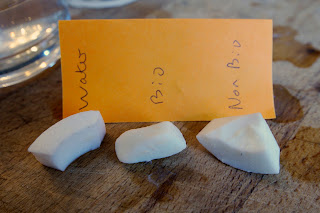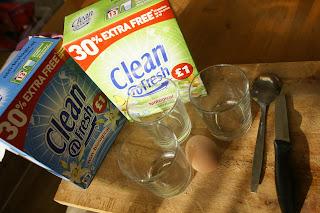The enzymes that are added to washing powders are like molecular scissors that chop up fats, starch and proteins, all of which cause stains on your clothes. The result is cleaner clothes without needing to use hot washes (because the enzymes work at low temperatures).
Its quite easy to see these enzymes in action with a nice simple demonstration using a hard boiled egg.
You'll need
- A hard boiled egg
- 2 or 3 glasses or jars
- A knife
- A teaspoon
- Biological washing powder/liquid
- If you are in the UK you can also buy non-biological washing powder (non-bio is only available in the UK because people here think it causes eczema, it doesn't).
What to do
1) Half fill the glasses with water and then mix in 1 teaspoon of biological washing powder/liquid into the first glass. If you have it add 1 teaspoon of the non-bio powder/liquid into the second glass. And leave the third glass with just water in it.
2) Chop the egg white into small pieces.
3) Place each piece in one of the glasses.
4) Leave the glasses in a warm place (like on a radiator or airing cupboard) overnight.
5) Inspect the bits of egg the next morning.
 |
| The bits of egg after sitting in the glasses overnight. |
What's going on?
One of the enzymes in the washing powder is known as a protease. It's a protein molecule that cuts up other proteins, some of which cause stains. But in this case the egg white, which is mainly protein, gets slowly digested by the protease. The result is a smaller bit of egg white.
I'm a big fan of proteins, they're fabulously intricate, beautiful structures that have evolved the perfect shapes and features required to do their jobs. And so I thought I'd share some of that wonder with you. This is what the protease in your washing powder looks like and (in part) you have it to thank for those nice clean pants.



I thought I was in small minority in finding enzymes interesting. They party hard!
ReplyDeletethank you
ReplyDeleteDoes this apply to all types of washing machines? This looks like a fun activity. I just hope this will not cause any damage to my washing machine.
ReplyDeleteWho said anything about washing machines?
Delete